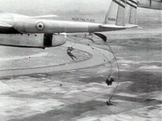Portal:1950s/Selected article
| This page is currently inactive and is retained for historical reference. Either the page is no longer relevant or consensus on its purpose has become unclear. To revive discussion, seek broader input via a forum such as the village pump. |
| Note: Article entries are now being transcluded directly on the main portal page. However, this page should be retained for historical reference. |
Selected article 1
Portal:1950s/Selected article/1 The Great Leap Forward (simplified Chinese: 大跃进; traditional Chinese: 大躍進; pinyin: Dà yuè jìn) of the People's Republic of China (PRC) was an economic and social campaign by the Communist Party of China (CPC) from 1958 to 1961. The campaign was led by Mao Zedong and aimed to rapidly transform the country from an agrarian economy into a communist society through rapid industrialization and collectivization. The campaign caused the Great Chinese Famine. (Full article...)
Selected article 2
Portal:1950s/Selected article/2
The Battle of Dien Bien Phu was the climactic battle of the First Indochina War between French Union forces and Việt Minh communist revolutionary forces. The battle occurred between March and May 1954, and culminated in a massive French defeat that effectively ended the war. The French undertook to create an air-supplied base at Điện Biên Phủ, deep in the hills of Vietnam, in order to cut off Viet Minh supply lines into the neighboring French protectorate of Laos. The Viet Minh, under General Võ Nguyên Giáp, surrounded and besieged the French, who were unaware of the Viet Minh's possession of heavy artillery. The Viet Minh occupied the highlands around Dien Bien Phu, and were able to fire down accurately onto French positions. Tenacious fighting on the ground ensued, reminiscent of the trench warfare of World War I. The French repeatedly repulsed Viet Minh assaults on their positions. Supplies and reinforcements were delivered by air, although as the French positions were overrun and the anti-aircraft fire took its toll, fewer and fewer of those supplies reached them. After a two month siege, the garrison was overrun and most French surrendered. Shortly after the battle, the war ended with the 1954 Geneva Accords, under which France agreed to withdraw from its former Indochinese colonies. (Full article...)Selected article 3
Portal:1950s/Selected article/3
Hurricane Hazel was the deadliest and costliest hurricane of the 1954 Atlantic hurricane season. The hurricane killed as many as 1,000 people in Haiti before striking the United States near the border between North and South Carolina, as a Category 4 hurricane. After causing 95 fatalities in the US, Hazel struck Canada as an extratropical storm. As a result of its damaging effects and high death toll, its name was retired and will never again be used for a hurricane in the North Atlantic basin. The effects of Hurricane Hazel in Canada included C$137,552,400 ($1,126,947,163 in 2009) in damages and 81 deaths. Hazel, the deadliest and costliest storm of the 1954 Atlantic hurricane season, as well as one of the deadliest and costliest storms of the 20th century, reached Toronto, Ontario by the evening of October 15, 1954. (Full article...)Selected article 4
Portal:1950s/Selected article/4
The 1952 Winter Olympics took place in Oslo, Norway, from 14 to 25 February. All of the venues for the games were located in Oslo's metropolitan area with the exception of the alpine skiing events, which were held at Norefjell, 113 km (70 mi) away. A new hotel was built for the press and dignitaries, along with three dormitories to house athletes and coaches, creating the first modern Olympic Village. The games attracted 694 athletes representing 30 countries, who participated in four sports and 22 events. There was one demonstration sport, bandy, in which three Nordic countries competed. Women were allowed to compete in cross-country skiing for the first time. Portugal and New Zealand competed at their first Winter Olympics, and Japan and Germany competed for the first time since World War II. Norway won the overall medal count with sixteen medals, seven of which were gold. Hjalmar Andersen from Norway was the most decorated athlete with three gold medals for speed skating. The games closed with the presentation of a flag (pictured) by the city of Oslo to the International Olympic Committee. The "Oslo Flag" has been displayed in the host city during each subsequent winter games. (Full article...)Selected article 5
Portal:1950s/Selected article/5

Selected article 6
Portal:1950s/Selected article/6 The Second Red Scare, also known as McCarthyism after Senator Joseph McCarthy, was a period of increased popular fear of communist espionage consequent to a Soviet Eastern Europe, the Berlin Blockade (1948–49), the Chinese Civil War, the confessions of spying for the Soviet Union given by several high-ranking U.S. government officials, and the Korean War. (Full article...)



